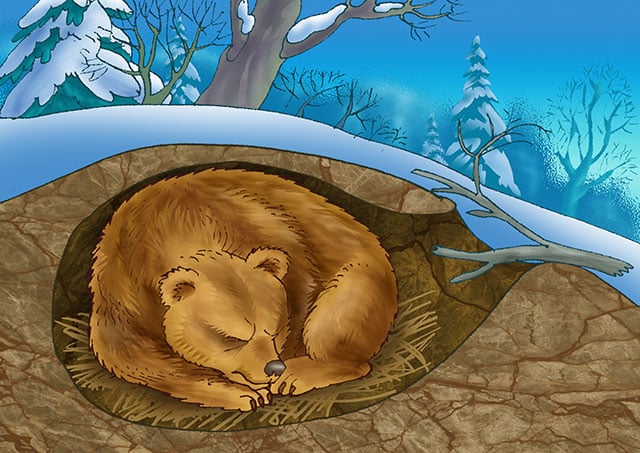Many creatures in the animal kingdom undergo total hibernation throughout the winter months to weather the worst seasons of the year. Yes, these creatures hibernate, but that’s not all there is to it.
Particular animals, such as woodchucks and snakes, go into hibernation periodically. However, there are various other methods of hibernation.
Consider the most well-known hibernating animals; in the coming winter, they have two options: flee or adapt. Winter may be particularly harsh for species that do not migrate.
What causes animals to enter a state of hibernation? Do they merely do it as a means of surviving the winter?
You are going to read an article that will explain why animals hibernate during winter.
What is Hibernation?
In a process known as hibernation, some animals can deliberately enter into a coma-like state and drastically reduce their metabolic rates. While hibernating, their energy consumption drops significantly.
Because of this, they can go without food and water. The animal seems to be sleeping or unconscious and is immobile during this state. Most animals hibernate in winter when there is not enough food or water.
Depending on how much energy the animal saved before hibernating, hibernation might last for weeks or even months. Even though it is a slow-down state, the animal’s physiology continues to function by consuming its fat reserves before hibernation.
Why Do Animals Hibernate?
Hibernation isn’t just for animals that experience cold weather; it’s a behavior that occurs throughout the year. So, some tropical hibernators may do just that to avoid the scorching heat.
- In some cases, temperature won’t matter.
- Some animals prefer hibernation due to food scarcity. For instance, following a fire in the forest, echidnas will hibernate until food supplies recover.
- The third motive is protection. During hibernation, animals don’t smell nor make any movements. So it becomes tough for predators to detect them. According to research, the monthly mortality rate of tiny mammals is five times higher when they are active than when they are hibernating.
- The fourth reason is active participation during the summer. Changes occur in nearly every animal species that hibernates during the winter. For instance, they experience a slowdown in metabolic activity, a steep drop in body temperature, and reduced respiration and heart rate to specific thresholds.
- Some creatures gain weight. These transformations can be so extreme that they seem lifeless to the naked eye. However, their energy levels increase to aid in hunting once the temperature rises and they emerge from hibernation. But I bet a lot of you have questions.
Is Hibernation an Identical Process for All Animals?
The only hibernating animals are jumping mice, groundhogs, and cave bats. The metabolic alterations are experienced by deep hibernation, rendering them entirely disabled. Therefore, it is tough for those endotherms (warm-blooded animals) to reawaken during winter.
In contrast, bears can respond to danger all winter long because their body temperature remains within the normal range of around 12 degrees Fahrenheit.
Again, Chipmunks and other animals lose heat quickly, so they must get up every few days to urinate, eat, and warm up. During the colder months, reptiles and amphibians enter a dormant state similar to hibernation. However, they will emerge from their slumber and seek water as the weather warms.
Woolly bear caterpillars and wood frogs are examples of amphibian and insect species that create a natural antifreeze, preventing their cells from freezing in freezing temperatures.
Interested in learning more about animals? Check out our previous blog, where we’ve covered about animals that start with t in detail!
Conclusion
Hibernation is incomparable to good sleep during the frigid winter months. It is a sign that we are preparing for the harsh winter months by entering a deep sleep. It is a defense mechanism for them.
Nevertheless, hibernation is unique to each species. While most animals doze off and look lifeless, a few remarkable bear species doze off, wake up, eat, and then sleep again.
Simply put, animals undergo a distinct hibernation process that causes them to undergo unique physiological changes that aid their survival.
Frequently Asked Questions
How Many Months Before Animals Start to Hibernate?
Typically, they hibernate in September or October. It will come out around April, six to seven months after that. Like bears, they hibernate as per a change in weather.
Do Animals Hibernate While Taking Food?
The majority of the time, they don’t require food. They require very little food during hibernation since their metabolism slows down significantly. They use very little energy during that time. They prepare themselves for storing the food.
When Does Hibernation End?
Seasonal food shortages, cold weather, and snow cover can induce hibernation, which can continue for four to seven months. They generally stop hibernation during spring due to longer days and a temperature rise.
Which Animals Do Not Go Into Hibernation?
Animals that do not hibernate are grouse, hares, deer, moose, voles and shrews. They don’t migrate and arrange their food in winter. The reason for not going into hibernation is they cannot actively reduce their body temperature.


